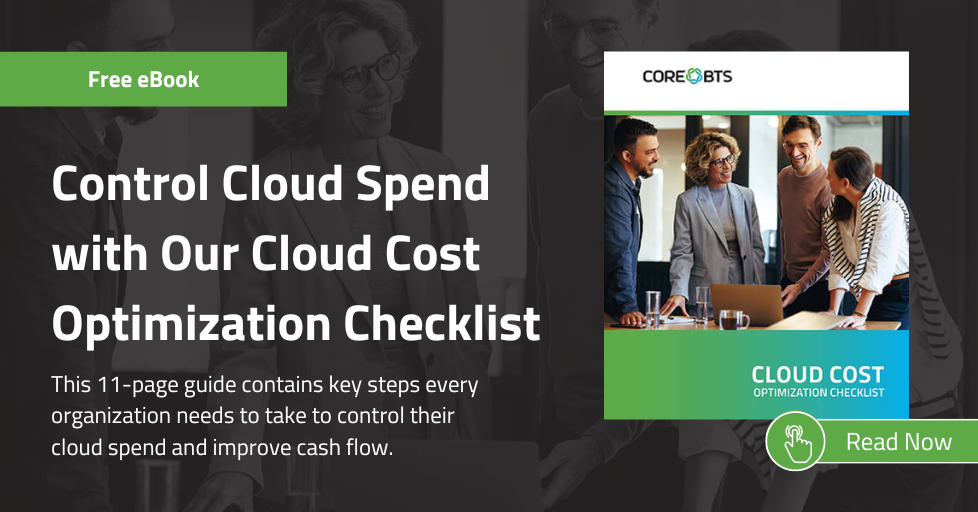The cloud made app development, data management, storage, and computing faster and easier – but now bills are coming due. And they’re not pretty. But we know it doesn’t have to be this way. You can stop the sprawl with CoreStratus – an Azure Cloud Cost Optimization and Financial Governance Solution from Core BTS.
In an age where digital transformation is more than just a buzzword, navigating the complex landscapes of cloud computing has become an important task for businesses worldwide.
Cloud computing powers innovation, propels growth, and creates meaningful opportunities. But, like all potent tools, the cost management of cloud services can be daunting. (Get your free copy of our Cloud Cost Optimization Checklist)
Whether selecting the right services, aligning resources with actual usage needs, or utilizing cost-efficient instances, every action contributes to streamlining cloud expenditures. Organizations can achieve substantial cost savings and run more efficient workloads by optimizing cloud spend, freeing up resources to invest in innovation and growth.
In this blog, we’ll look at the nuances of cloud cost optimization, offering you insights into practical strategies, tools, and best practices geared toward creating a robust framework for efficient cloud management.
Cloud Computing and Its Cost Implications
To grasp the concept of cloud cost optimization, let’s first begin with understanding the landscape of cloud computing.
At its core, cloud computing is the delivery of different services via the Internet. Major cloud providers, like AWS, Azure, and Google Cloud, offer a wide variety of services tailored to all kinds of business needs, including servers, storage, databases, networking, software, and analytics. By leveraging cloud services like these, businesses can innovate faster, scale according to need, and control costs more effectively.
Understanding cloud computing pricing models is an important aspect of cost optimization. Much like the utility services you pay for in your home, the amount you pay for cloud computing depends on your usage and choosing the cloud storage architecture best suited to your needs can significantly impact your overall cloud cost.
8 Cloud Cost Optimization Strategies
Effective cloud cost management requires selecting the right resources, monitoring usage, and implementing governance policies to ensure efficient and cost-effective use. Here are eight strategies to help you strike the perfect balance.
1. Right-Sizing
What is it?
Right-Sizing involves matching the resources provisioned with actual usage needs. Over-provisioning can lead to wasted resources and higher costs, while under-provisioning can result in performance issues.
Why is it important?
Aligning the resources with the needs of your business ensures that you are neither overspending on unnecessary capacity nor facing bottlenecks due to inadequate resources. This balance is crucial for efficiency and cost-effectiveness.
How to do it
Analyze your current workloads to understand their resource requirements. Utilize tools provided by cloud service providers, such as AWS Cost Explorer or Azure Advisor, to help with this analysis. Select the appropriate resources that meet your current demands and remember that cloud services are scalable – meaning you can adjust as your needs change.
2. Reserved Instances
What is it?
Reserved Instances (RIs) allow you to commit to a cloud provider for a certain period (usually 1-3 years), which lets you utilize an array of services at a substantially discounted rate compared to on-demand pricing.
Why is it important?
For predictable workloads where you have a good understanding of the resources needed, opting for RIs can significantly support cost-saving initiatives.
How to do it
Assess your long-term resource usage and discuss available RI options with your cloud provider. Negotiate terms and conditions that are in sync with your business objectives.
3. Auto-Scaling
What is it?
Auto-scaling is an automated cloud platform system that adjusts resources based on demand.
Why is it important?
By ensuring that resources are scaled up or down based on actual needs, auto-scaling prevents overpaying during low-demand periods and avoids performance issues during high-demand periods.
How to do it
Define auto-scaling policies that dictate when resources should be added or removed based on factors like traffic or server load.
4. Cost Monitoring
What is it?
Cost Monitoring involves tracking and analyzing metrics that impact cloud-based expenses to recognize cost trends and pinpoint areas where optimization tools may be needed.
Why is it important?
Monitoring cloud costs ensures you know where your money is going. This information is critical to making informed decisions on resource allocation and budgeting. It also helps detect cost anomalies, prevent budget overruns, and identify opportunities for cost savings.
How to do it
Take advantage of the cost monitoring tools offered by your cloud providers, such as AWS Cost Explorer, Azure Cost Management, or Google Cloud’s Cost Tools. These tools give you a general overview of your expenditures. For more detailed insights and recommendations, consider using third-party solutions that offer more detailed insights. Regularly review the data, analyze trends, and use the insights to adjust your cloud strategy.
By integrating cost monitoring into your routine management practices, you ensure the continual optimization of your cloud infrastructure, which is pivotal for maximizing the return on your cloud investments.
Real-time monitoring of your cloud costs can provide immediate insights into your expenditure patterns, helping you promptly identify areas of overspending and optimize accordingly.
At Core BTS, we offer real-time cloud cost monitoring solutions that can help you manage and control your cloud costs effectively. See how we can help your organization with real-time cloud cost monitoring.
5. Cloud Governance
What is it?
Cloud Governance entails implementing policies and rules that manage and oversee your cloud environment, ensuring compliance, security, and cost optimization. This can include setting spending limits, tagging resources for easier management, and implementing approval workflows for new resources.
Why is it important?
Without governance, a cloud environment can quickly become disorganized with sprawling resources, security vulnerabilities, and skyrocketing costs. Cloud Governance ensures order, security, and efficiency. It also ensures that your company complies with legal and regulatory requirements, saving you from potential fines and legal issues.
How to do it
Start by developing a cloud governance policy that aligns with your business goals and regulatory requirements. Set clear guidelines on spending limits and usage to prevent budget overruns. Implement tagging for resources, which can help track costs and usage for specific projects, departments, or any other logical groupings that make sense for your organization.
You’ll then work on establishing approval workflows to control the provisioning of new resources, ensuring that every new addition is justified and monitored.
Leverage cloud management and governance tools offered by your cloud service provider or third-party vendors, which can automate and streamline these processes. Examples include AWS Management and Governance, Azure Policy, and Google Cloud’s Cloud Identity and Access Management (IAM).
Effective cloud governance aims not to restrict usage but to empower users to leverage cloud resources wisely, securely, and cost-effectively.
Exploring alternatives to your current storage solutions can also lead to cost savings. At Core BTS, we have curated a guide that provides a deeper understanding of the advantages and alternatives to cloud storage solutions. It’s a must-read for anyone working on optimizing cloud costs.
6. Serverless Technologies
What is it?
Serverless technologies such as Azure Kubernetes Services (AKS), AWS Lambda, Microsoft Azure Functions, and Google Cloud Functions allow you to run applications and services without managing the underlying infrastructure. You can execute code, manage databases, and use other services without worrying about the servers – the cloud provider takes care of it.
Why is it important?
Serverless technologies can significantly streamline operations and optimize costs. Without managing servers, you can focus on your core business logic. The serverless model is typically event-driven and only charges for the compute time you consume, so you don’t pay for idle resources.
How to do it
Evaluate your applications and services to determine which parts could benefit from a serverless approach. For example, functionalities that experience variable traffic or are not continuously used are prime candidates.
Next, choose a serverless platform that aligns with your cloud usage needs. AWS Lambda, Azure Functions, and Google Cloud Functions are popular options. Migrate or build the selected applications using the serverless architecture.
Remember that while serverless technologies can offer cost savings, they also require a different approach to development and monitoring. Ensure your team is current with best practices for serverless environments.
7. Spot Instances
What is it?
Spot instances are spare cloud computing capacity that you can use at a significantly reduced cost compared to on-demand instances. Paired with load balancing – distributing workloads across multiple resources to optimize system efficiency – spot instances can be a great way to save costs for non-critical or fault-tolerant workloads.
Why is it important?
For workloads that aren’t time-sensitive and can handle interruptions, spot instances can significantly reduce costs for tasks that aren’t critical. Different instance types come with different configurations and capacities, allowing you to choose the ones that best match your workload requirements at reduced costs. Spot instances also enable you to bid on unused cloud resources (including various instance types), allowing you to use them at lower prices than the standard rates.
How to do it
Identify which workloads can be allocated to spot instances. Within those workloads, determine the suitable instance types that meet your needs in terms of memory, compute power, and storage. Monitor pricing trends for these instance types and make effective bids. It’s important to note that spot instances can be terminated by the cloud provider when the resources are needed for other customers, so they are best suited for flexible and non-urgent tasks.
8. Cloud-Native Services
What is it?
Cloud-native services are solutions that are built and optimized for cloud environments. These can range from databases to containers, serverless functions, data processing tools, and more. These services are designed to take full advantage of cloud capabilities such as scalability, flexibility, and automation.
Why is it important?
Using cloud-native services can streamline your operations and result in cost savings. Since these services are optimized for the cloud, they often perform better and are more reliable than traditional or self-hosted solutions. Additionally, by using cloud-native services, you offload the maintenance and management burden to the cloud provider, allowing your team to focus on business-critical tasks.
How to do it
Start by identifying the areas of your cloud infrastructure where cloud-native services could provide value. For example, you might opt for a cloud-native database service like Amazon RDS or Azure SQL Database instead of hosting your own database.
Next, evaluate the cloud-native services offered by your cloud provider and determine which ones meet your performance, scalability, and cost requirements.
When transitioning to cloud-native services, ensure your team is familiar with the best cost optimization practices for the chosen managed services. Implement monitoring and governance policies to track the performance and costs of these services.
Core BTS Can Help
The key to cloud cost optimization is not just knowledge but tailored action. Every organization is unique, and so should its cloud spending strategies should be as well. But how do you tailor these strategies and implement them effectively?
Core BTS is an expert in helping organizations like yours customize and execute cloud spending strategies. With our deep expertise in cloud services and IT consulting, we can work closely with you to understand your unique needs, create tailored cloud spending strategies, and help you implement them for immediate impact.
If you are looking for ways to optimize your cloud investment to improve cash flow, then contact us. Our cloud experts can show you how to make sure you’re only paying for what you need.





